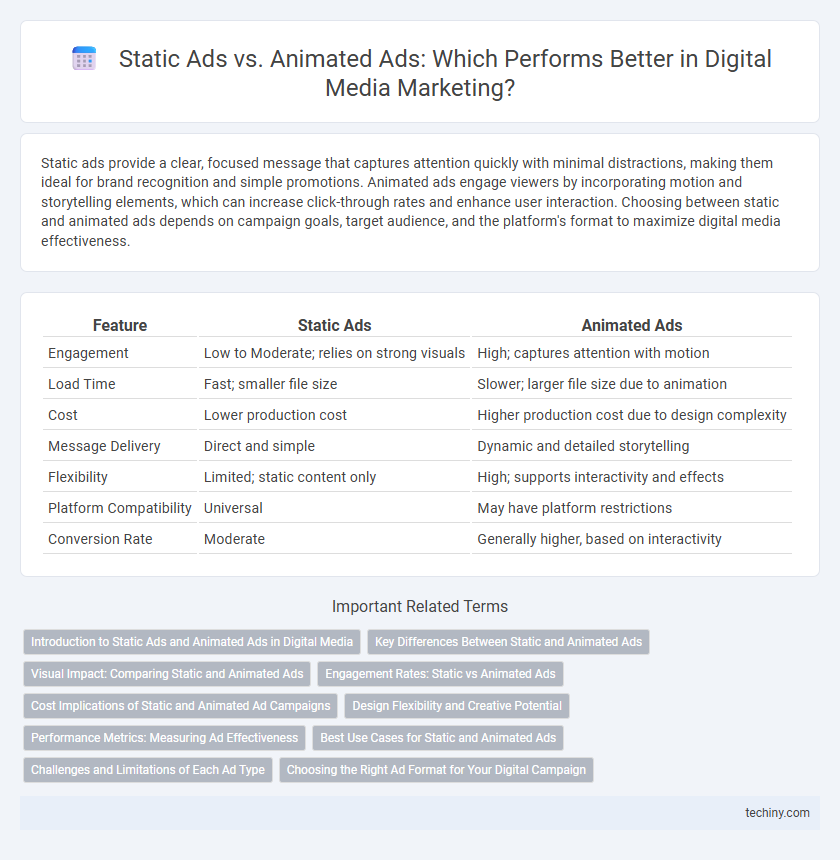Static ads provide a clear, focused message that captures attention quickly with minimal distractions, making them ideal for brand recognition and simple promotions. Animated ads engage viewers by incorporating motion and storytelling elements, which can increase click-through rates and enhance user interaction. Choosing between static and animated ads depends on campaign goals, target audience, and the platform's format to maximize digital media effectiveness.
Table of Comparison
| Feature | Static Ads | Animated Ads |
|---|---|---|
| Engagement | Low to Moderate; relies on strong visuals | High; captures attention with motion |
| Load Time | Fast; smaller file size | Slower; larger file size due to animation |
| Cost | Lower production cost | Higher production cost due to design complexity |
| Message Delivery | Direct and simple | Dynamic and detailed storytelling |
| Flexibility | Limited; static content only | High; supports interactivity and effects |
| Platform Compatibility | Universal | May have platform restrictions |
| Conversion Rate | Moderate | Generally higher, based on interactivity |
Introduction to Static Ads and Animated Ads in Digital Media
Static ads in digital media are fixed images or graphics designed to convey a clear, concise message with minimal distractions, typically used for brand awareness and direct calls to action. Animated ads incorporate motion, such as transitions, effects, or characters, enhancing engagement and visual appeal to capture user attention more effectively than static counterparts. Both formats leverage different strengths to optimize digital advertising campaigns across platforms like social media, websites, and video networks.
Key Differences Between Static and Animated Ads
Static ads deliver a single, unchanging image designed for quick recognition and straightforward messaging, often resulting in faster loading times and easier scalability across platforms. Animated ads use motion graphics and dynamic elements to capture attention, enhance storytelling, and boost engagement through visual movement and interactive features. Key differences include user interaction levels, production complexity, and effectiveness in conveying complex messages.
Visual Impact: Comparing Static and Animated Ads
Static ads deliver clear, straightforward messages through high-quality images and concise text, ensuring quick recognition and retention. Animated ads enhance visual impact by incorporating movement, color changes, and transitions that capture attention more effectively and convey complex messages dynamically. Studies show animated ads often increase viewer engagement and click-through rates, making them more effective in competitive digital media environments.
Engagement Rates: Static vs Animated Ads
Animated ads typically generate higher engagement rates than static ads by capturing viewer attention through movement and dynamic visuals. Studies show animated ads can increase click-through rates by up to 30% compared to static ads, enhancing user interaction and message retention. While static ads offer simplicity and faster load times, animated ads deliver a more immersive experience that drives stronger audience engagement.
Cost Implications of Static and Animated Ad Campaigns
Static ads typically incur lower production costs due to simpler design requirements and reduced resource needs, making them ideal for budget-conscious campaigns. Animated ads, while more expensive to produce because of their dynamic content and longer development timelines, often generate higher engagement rates and better ROI when targeting interactive digital platforms. Budget allocation for ad campaigns should balance the initial cost of animation against potential performance benefits in click-through and conversion metrics.
Design Flexibility and Creative Potential
Static ads offer simplicity and clarity with fixed visuals that ensure key messages remain consistent, making them ideal for brand recognition and quick communication. Animated ads provide greater design flexibility, allowing dynamic storytelling and interactive elements that capture attention and engage viewers more effectively. The creative potential of animated ads enables marketers to experiment with motion, transitions, and multimedia integration, enhancing user experience and driving higher conversion rates.
Performance Metrics: Measuring Ad Effectiveness
Static ads typically yield higher click-through rates (CTR) on desktop platforms, while animated ads demonstrate superior engagement and conversion rates on mobile devices. Performance metrics such as viewability, interaction rate, and time spent on ad further distinguish the effectiveness of animated ads in capturing audience attention. Leveraging real-time analytics tools enables precise measurement of impressions, CTR, and return on ad spend (ROAS) for both static and animated campaigns.
Best Use Cases for Static and Animated Ads
Static ads perform best in environments with limited attention spans and quick message delivery needs, such as social media banners and email marketing campaigns, due to their simplicity and fast loading times. Animated ads excel in engaging audiences on websites, video platforms, and mobile apps by using motion and interactivity to capture attention and convey complex stories or brand messages effectively. Brands targeting increased click-through rates and conversions benefit from animated ads in retargeting campaigns and rich media placements where visual engagement drives user action.
Challenges and Limitations of Each Ad Type
Static ads face challenges in capturing audience attention due to their limited visual engagement and inability to convey complex messages dynamically. Animated ads often encounter limitations such as higher production costs, longer development time, and possible loading delays that affect user experience on slower networks. Both ad types require strategic placement to optimize visibility without overwhelming the viewer or causing ad fatigue.
Choosing the Right Ad Format for Your Digital Campaign
Static ads deliver a clear and simple message through images or text, making them ideal for brand recognition and quick engagement. Animated ads capture attention with motion and storytelling elements, increasing user interaction and click-through rates. Selecting the right ad format depends on campaign goals, target audience behavior, and platform capabilities to maximize digital advertising effectiveness.
Static Ads vs Animated Ads Infographic

 techiny.com
techiny.com